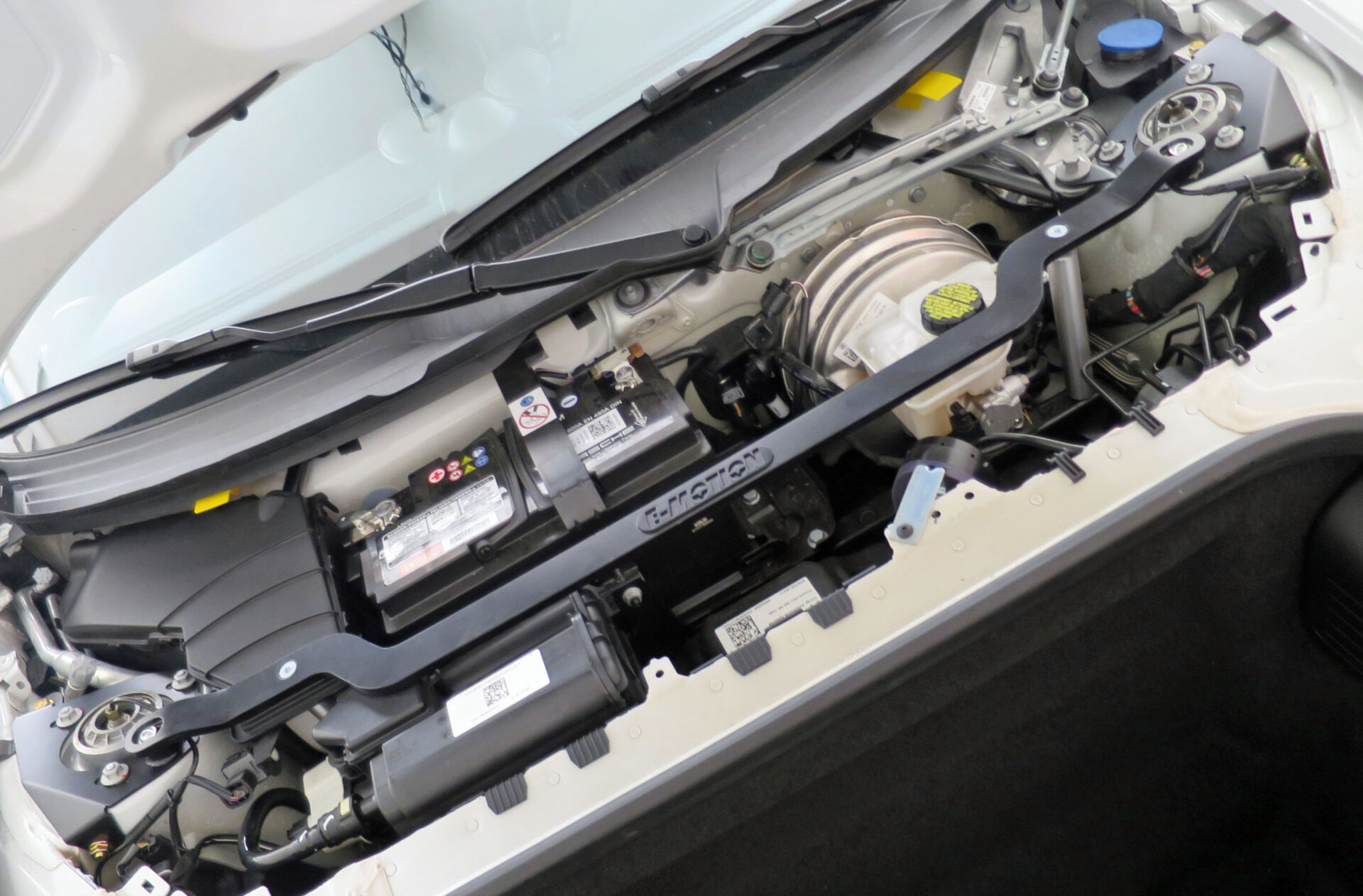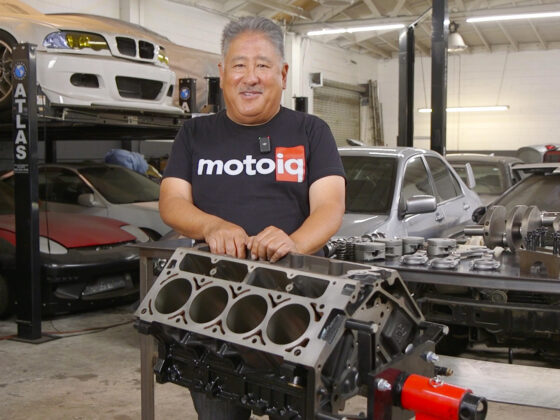 One test for the reinforcement brace system was to drive up Angeles Crest Highway which is bumpy in some sections.
One test for the reinforcement brace system was to drive up Angeles Crest Highway which is bumpy in some sections.
 There are always some interesting rides up there and this old 911 has a fat intercooler in the rear deck.
There are always some interesting rides up there and this old 911 has a fat intercooler in the rear deck.
 The COBB AccessPort is great, but I don’t like that it requires a cable to be hooked into the OBD2 port. For everyday driving, I like to keep tabs on the intake air temps. So, I got an OBDLink MX and use their app with an old Pixel phone I had collecting dust. I would like to monitor ignition timing correction, but I’ll see if I can figure that out later. I originally got the OBDLink MX to hack into the CAN signal and use the RaceChrono app to monitor data streams; someone had figured out how to plug into the Soundaktor module harness for the CAN signal. However, somewhere between 2018 and 2023, Porsche moved the Soundaktor module to someplace not visible. So, I decided to just go through the OBD2 port. To hold the phone, I found a holder off of Amazon for under twenty bucks and it works pretty well.
The COBB AccessPort is great, but I don’t like that it requires a cable to be hooked into the OBD2 port. For everyday driving, I like to keep tabs on the intake air temps. So, I got an OBDLink MX and use their app with an old Pixel phone I had collecting dust. I would like to monitor ignition timing correction, but I’ll see if I can figure that out later. I originally got the OBDLink MX to hack into the CAN signal and use the RaceChrono app to monitor data streams; someone had figured out how to plug into the Soundaktor module harness for the CAN signal. However, somewhere between 2018 and 2023, Porsche moved the Soundaktor module to someplace not visible. So, I decided to just go through the OBD2 port. To hold the phone, I found a holder off of Amazon for under twenty bucks and it works pretty well.
 The issue with the OBD2 port is that the 12V power wire in the connector is always on. I don’t want to kill the battery, so I had to get a 12V switched source from somewhere else. I got an OBD2 coupler to locate the OBDLink MX somewhere out of the way and I hacked the harness to get switched 12V power.
The issue with the OBD2 port is that the 12V power wire in the connector is always on. I don’t want to kill the battery, so I had to get a 12V switched source from somewhere else. I got an OBD2 coupler to locate the OBDLink MX somewhere out of the way and I hacked the harness to get switched 12V power.
 The wire I pulled out from the bundle is the wire for 12V power in the OBD2 connector, pin 16.
The wire I pulled out from the bundle is the wire for 12V power in the OBD2 connector, pin 16.




11 comments
Shame they didn’t double bolt the bar. The bar can only handle tension and compression and no bending moment as designed.
Spoke too soon. My bad. Nice tie in to the subframe. Didn’t see it initially.
Yup, it’s a super beefy support bar for the heavy factory battery. Quick search shows the factory battery is about 45 lbs.
Strut/shock tower loads are basically vertical-a horizontal bar does little but add weight.
Remember this is a strut setup, so lateral loads are transmitted into to strut towers. Notice Porsche has black bars going from the strut towers to the rear bulkhead to add strength. Uneven vertical loading, from bumps or cornering, will try to twist the chassis and a rigid horizontal bar can add some resistance against that twisting. This particular design from E-Motion ties the horizontal bar to the strong battery brace that runs the span of of the chassis, boxing it in. Additionally, by tying down the horizontal bar to the battery brace bar, it’s clamping down on the top of the strut towers to help resist the vertical loads which have lead to strut tower failure on this chassis.
Lateral loads at the top of the strut are quite light as most lateral loading goes through the lower arm to the chassis.
I’ll calculate some approximate numbers. My car is about 3000lbs with 45%/55% weight distribution and I’ve pulled 1.4G lateral. At max lateral G, we can assume the inside front tire is not loaded to simplify the napkin calculation. I assumed the control arm is 6″ above ground and the strut tower is 24″ above ground. Crunching the numbers, it’s about 1890lbs at the tire contact patch, 2520 lbs at the control arm joint, and 630lbs at the strut tower. Those are all the lateral loads. Remember, there’s still the vertical load on the strut tower that’s about 1350lbs. And that vertical load is trying to cause displacement of the strut tower relative to the other strut tower; i.e. twisting the chassis. And the E-motion brace setup resists that vertical displacement and lateral loads. If you didn’t already look up GT4 strut tower failures, go ahead and look.
Photos of the strut tower failure imply a vertical component caused the failure, not a lateral load. Vertical loads are considerable when the suspension is fully compressed. That bar you are hawking does nothing for vertical loads.
Of course it’s a vertical load that causes the failure of the strut tower. And I mentioned that in the article when I mentioned sharp impacts. I would note, I never asked E-Motion for any type of discount and they didn’t even know I was writing an article on the reinforcement brace; so, I’m not ‘hawking’ anything. Same goes for their suspension components; I paid full price including the installation costs.
And of course the brace system counteracts vertical loads. Even if it were just the bar alone, it would have some resistance to vertical loads because the bar attaches to the strut tower cap piece as a rigid joint which resists bending, as opposed to many bars that have a heim joint that would rotate. But what really helps this brace system resist the vertical loads are the two vertical posts that tie the bar to the battery sub brace. Those two posts are fastened with M8 size fasteners; you could lift the front of the vehicle from the E-motion brace because of how the braces uses the vertical posts to tie to the chassis.
Go ahead, draw out the free body diagram and analyze the loads and interactions.
You’re the one selling something. You draw a diagram and be sure to include the CG, roll center, and wheel diameter this time. You left out those items in your last calculation.
Selling would imply I’m getting something of value in return, which I’m not. You’re the one who made a blanket statement, “Lateral loads at the top of the strut are quite light” without providing any quantitative value. So, I did a quick estimation using some values specific to my car. If you don’t like my simplified calculation, then do your own work and show it in order to provide a value that backs up your statement.
You said the bar does nothing for vertical loads. I described how the brace system does counteract the loads. If you dispute my analysis, draw it out and prove it.